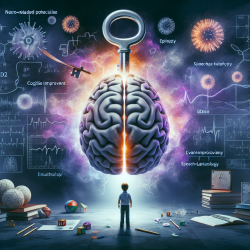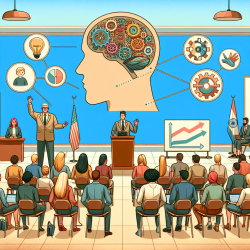Introduction
In the world of speech-language pathology and cognitive therapy, data-driven insights are invaluable. A recent study titled "Evaluation of a neurotherapy program for a child with ADHD with Benign Partial Epilepsy with Rolandic Spikes (BPERS) using event-related potentials" provides compelling evidence on the efficacy of neurotherapy in addressing cognitive deficits associated with ADHD and BPERS. This blog aims to shed light on the study's findings and encourage practitioners to integrate these insights into their therapeutic approaches.
The Study Overview
The study focuses on a 9.3-year-old patient, E.Z., who exhibited significant cognitive dysfunctions, particularly attention deficits, due to BPERS and ADHD. Despite traditional antiepileptic treatments, E.Z. showed limited progress. The research introduced a neurotherapy program combining relative beta training and behavioral training, aiming to regulate brain function dynamics.
Key Findings
The study's results were promising:
- Cognitive Improvement: E.Z. demonstrated significant improvements in verbal and non-verbal IQ, immediate and delayed logical and visual recall, and executive functions.
- Physiological Changes: There was a notable decrease in epileptic spikes and an increase in the P300 NOGO component, indicating enhanced brain function.
- Behavioral Adjustments: The neurotherapy led to reduced neuropsychiatric symptoms, allowing E.Z. to function more independently in school and daily life.
Implications for Practitioners
For speech-language pathologists and cognitive therapists, these findings underscore the potential of integrating neurotherapy with traditional treatments for children with ADHD and BPERS. The study highlights the importance of:
- Personalized Therapy: Tailoring neurotherapy programs to individual needs can significantly enhance outcomes.
- Event-Related Potentials (ERPs): Utilizing ERPs can provide valuable insights into functional brain changes and guide therapy adjustments.
- Continued Research: Practitioners are encouraged to explore further research and contribute to the growing body of knowledge on neurotherapy's efficacy.
Conclusion
The study offers a beacon of hope for children struggling with ADHD and BPERS, showcasing the transformative power of neurotherapy. As practitioners, embracing these insights can lead to more effective interventions and improved outcomes for our young patients.
To read the original research paper, please follow this link: Evaluation of a neurotherapy program for a child with ADHD with Benign Partial Epilepsy with Rolandic Spikes (BPERS) using event-related potentials.










